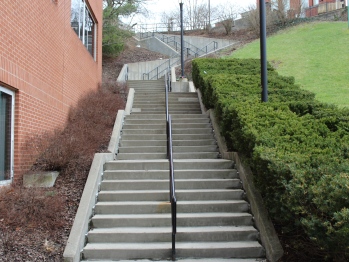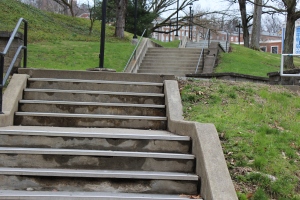By: Ashley Conley
It’s officially spring and the weather is getting warmer, which means you may be more inclined to take the stairs as you move from class to class on the campus of West Virginia University! *Note: This is the perfect time to add A Thousand Miles by Vanessa Carlton to your Strolling to Class playlist.*
Of course, taking the stairs is always a healthier option than taking an elevator to avoid the extra effort, but is it really beneficial? For years, WVU students have complained about the mass number of stairs and have seemingly assumed that just because they have to face dreadful staircases like the Life Science stairs (also known as the LSB stairs) every day, they may not gain the famed “Freshman 15”.
Unfortunately, this assumption is #FakeNews.
“welcome to wvu hope u like stairs”- something my tour guide did NOT tell me
— annoyin’ genius (@jenny_buchheit) January 19, 2017
The most valuable effect of taking the stairs isn’t weight loss.
If you’re a student or have visited the campus, you know all about the LSB stairs. 76 strides up, these bad boys will take your breath away. Sadly, the reality is that this set of stairs isn’t even remotely close to a tiny fraction of your daily exercise needs.
According to The Baton Rouge Clinic, a person that weighs between 150 and 160 pounds can burn roughly 10 calories per flight of stairs. That means you can burn close to 63 calories by walking up the LSB stairs one time. This is a start, but…

The LSB stairs
…to put that into perspective, you need to burn 500 to 1,000 calories more per day than you consume just to lose one or two pounds in a week’s time, per LIVESTRONG. So, those of us who weren’t blessed with a fast metabolism and live off pizza and ice cream will need to do much more than just take the stairs to avoid that oh-so-frightening college weight gain.
“LSB is long and steep and usually crowded,” said Dustin Hamrick, a senior at WVU who finds the copious staircases to be an added displeasure to his daily routine. “And if you’re on crutches or disabled, you have almost no chance (of making it to the top).”
Conveniently, there’s an elevator located in the nearby Brooks Hall for those physically unable to take the stairs or for those who just don’t feel like breaking a sweat.
A tour group just walked up the LSB stairs and half had to stop to catch their breath.. At least we know which half won’t be attending WVU
— Jordan Devine (@SoDevinex3) March 1, 2017
Tracking your calories? Here’s what a person weighing between 150 and 160 pounds can expect to burn by taking other popular staircases at WVU (keep in mind that results vary based on exact weight and intensity of the stair climb):

The Stalnaker stairs
42 steps = roughly 35 calories burned per climb.

The Brooks-Woodburn stairs
90 steps = roughly 75 calories burned per climb.

The Armstrong stairs
48 steps = roughly 40 calories burned per climb.

The B&E stairs
52 steps = roughly 43 calories burned per climb.

The CAC stairs
72 steps = roughly 60 calories burned per climb.
“It helps to be in shape when going to this school,” said Mike Nadera, also a senior at WVU, who actually avoids the elevators to take the stairs. “With all the hills, stairs and the elevation itself, it makes we want to be in better shape so I’m not huffing and puffing when I get to my classes. When the elevators get busy, a person is going to wish they were ready to take on the environment here.”
De-stressing and improving your mood for the win!
Although walking up stairs on your way to class doesn’t burn enough calories to make a noticeable difference in your weight, there are plenty of long-term health benefits that stem from seemingly small exercises. According to Daniel Bonner, an associate professor of human performance and exercise physiology at WVU, these exercises (such as taking the stairs or parking further away from doors to boost your step count) can increase your oxygen consumption; increase blood flow to your brain and other vital organs; strengthen key muscles; improve your mood and even relieve stress.
“The benefits of even small changes in activities were the premise for Small Steps, the National Guard campaign known as Guard Your Health, which encourages people to make the effort to do small bouts of daily activity,” Bonner said.
Ironically, the first step of the Small Steps challenge, that began on March 1, was to take 5-10 flights of stairs.
“These (activities) guard against hypokinetic diseases, or conditions that come as a result of being sedentary,” Bonner said. “Another benefit is that many viruses are spread in areas where there are many people crowded in to a confined area (elevators, busses, PRT cars, etc.). There are fewer people walking the stairs and walking around in general, so that alone will make you less likely catch a virus from someone.”
Lmao people complaining about how many stairs there are at WVU is such a first world problem
— Kyle Seese (@kseese7) February 9, 2017
Next time you trek to class on the WVU campus, keep in mind that by simply choosing the stairs over the elevator, you could do your health more than one favor. It only takes a few moments and a little bit of effort, and who knows – you might actually enjoy it.
Images in this article provided by the author.
Ashley Conley is a senior journalism student at WVU. She aspires to become a writer or reporter in the sports industry upon graduation. You can follow her on Twitter @ashleyconleyyy.

Ashley,
I really liked this post! People are always complaining about the LSB staircase which is kind of funny but so relatable at the same time. Its such a well known topic so writing a story over it only seems fitting. The incorporation of the screenshots from students here at WVU only gave off more of a sense of inclusion knowing that we aren’t alone in the topic. Overall I really liked this!
LikeLike
Thank you for the feedback, Mia!
LikeLike
I think this is a great first post, Ashley! I immediately knew I would get a little chuckle out of this because of how many complaints I hear on a daily basis (some coming from myself). It is funny because I like to think I am pretty healthy. With the exception of my drinking habits, I work out 5 times a week and eat a healthy, balanced diet. But I find that no matter how in shape I think I am, those stairs ALWAYS suck. Every single set of them! It is ridiculous. But anyways, I think your sources were great in this post. They really supported what you were trying to get across to your readers. I definitely agree with the statement regarding better health just because the stairs are less crowded. I do that all the time in the Evansdale Crossing because the elevators are like a mad house. I definitely agree that taking the stairs is a healthy choice on other levels. (Oh my goodness…that was a pun!!!) Overall, great first post! Keep up the humor throughout because it made it more fun to read!
LikeLike
Thank you for the awesome feedback, Carly!
LikeLike
This post literally is awesome! Even as me being an athlete I try to avoid all stairs as much as I possible can. I can’t even get up a flight without being winded. And I think I can speak for all WVU students when I say the stairs here are students worst enemy. Especially the LSB staircase, everyone walks over to Brooke’s Hall to go up the elevator instead of climbing the staircase. Great post!!!
LikeLike
Thanks for the feedback, Zaakira!
LikeLike